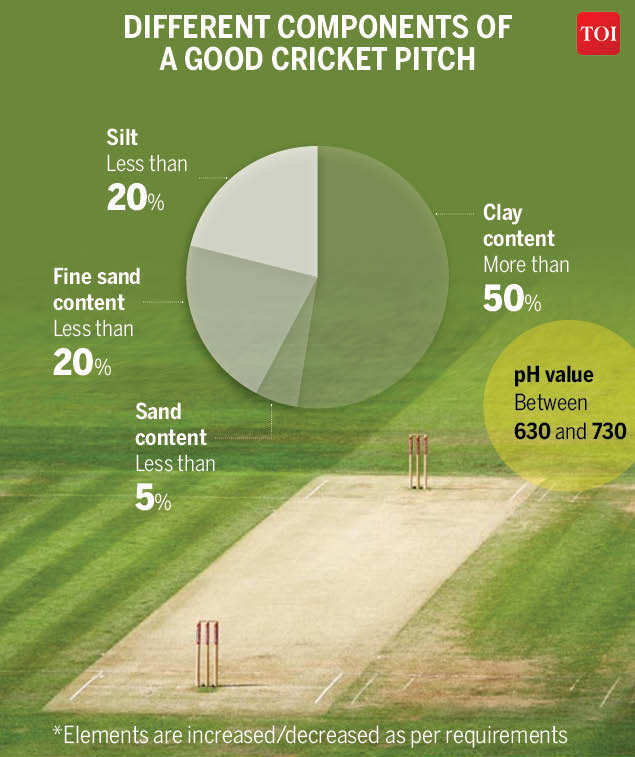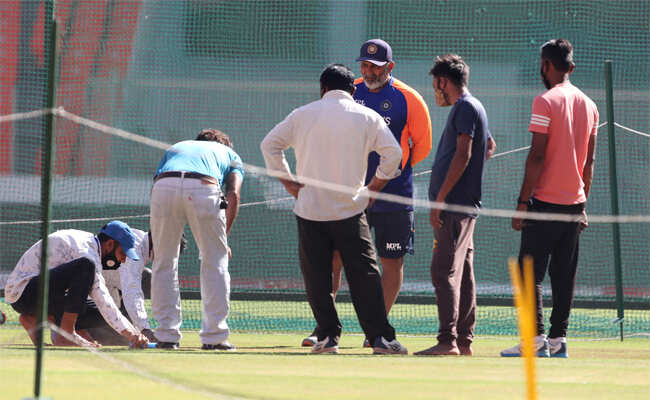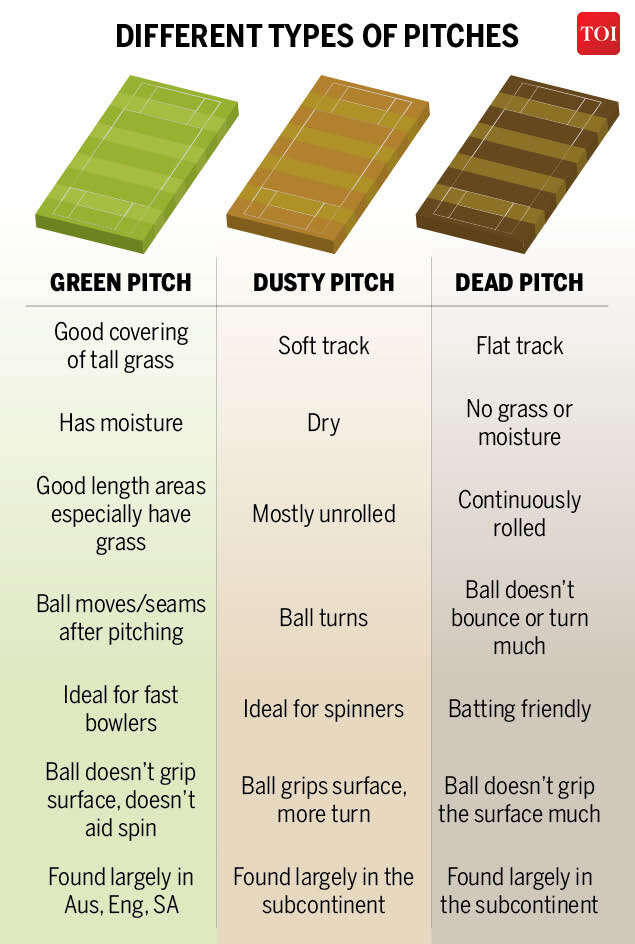Indian cricket and the perpetual pitch debate | Cricket News – Times of India
The same holds true for opinions voiced about cricket pitches in a high profile Test series.
THE PITCH DEBATE – WHAT IS A GOOD SURFACE?
When India were bowled out for their lowest Test-innings total of 36 in Australia recently, no one blamed the pitch for having demons in it. Virat Kohli & Co had batted decently in the first innings, so their fall in the second was a mixture of self-destruction and the talent that the likes of Josh Hazlewood and Pat Cummins possess.
Soon after India’s embarrassing loss in that pink-ball Test at Adelaide, former England captain Michael tweeted: “Told ya … India are going to get hammered in the Test Series … #AUSvIND #4-0.”
Told ya … India are going to get hammered in the Test Series … #AUSvIND #4-0
— Michael Vaughan (@MichaelVaughan) 1608367121000
Not a word on the pitch, and correctly so. What else would a batsman expect than pace and bounce when playing Down Under. If anything, Vaughan spurred India on, and the Englishman had to eventually eat his words. India went on to win the four-Test series 2-1.
Two months later, England came to India and won the first Test in Chennai. A few days later, they lost the second Test on a different pitch at the same venue and the criticism began.
“If England win this week having lost the toss on this beach … it will be a remarkable Victory … #INDvENG,” Vaughan had tweeted during the second Test.
If England win this week having lost the toss on this beach … it will be a remarkable Victory … #INDvENG
— Michael Vaughan (@MichaelVaughan) 1613196528000
Isn’t that complete disregard of the conditions in a different part of the world? Would you expect England-like swing or Australia-like bounce in dry Indian conditions? And did India complain after crashing to 36 in Adelaide or for 42 in the Lord’s Test of the 1974 tour?
As the pitch debate rages on, those who have defended the pitches on offer so far have pointed to the fact that the format is called ‘Test’ cricket for a reason.
01:49How a cricket pitch is prepared
“The beauty of this game is the challenging conditions, adapting to those,” former India all-rounder and ex-Karnataka coach Vijay Bharadwaj said while talking to Timesofindia.com earlier.
The Chennai track was no doubt a tough one to bat on, and the one used for the day-night third Test at Motera was even more challenging. England lost inside two days. While there is always space for constructive criticism no one should completely disregard the different challenges and conditions that teams face while travelling.
Most Indian fans though feel that the nature of the pitch for the fourth Test vs England should be different to that used in the third Test. The fact that the third Test finished inside two days is perhaps the biggest motivating factor here. No one really wants to see a Test match finish in two days, regardless of which side of the pitch debate they are on. So, it’s natural for fans to feel that a different pitch might produce a different kind of contest. One that will really ‘Test’ both teams equally.
Joe Root scored a double hundred in the first Test, his 100th, in Chennai. You need such class acts to succeed at the Test level that throws up different challenges, of which the pitch is one.
And that opens up a larger discussion. Just like foreign batsmen need to play spin regularly and get used to the turning tracks of the subcontinent to come to a country like India and dominate, subcontinental batsmen need to be trained to play on faster, seaming pitches.

Joe Root inspects the pitch during a practice session ahead of the fourth Test. (AFP Photo)
ARE YOUNGER SUBCONTINENTAL BATSMEN SCARED OF THE BOUNCE BECAUSE OF LACK OF EXPERIENCE ON SUCH PITCHES?
How big a role does fear play when a cricket team travels to a foreign land? When the Aussies, English or Proteas come to India, they might be scared of the prodigious turn that the pitches here can offer. Similarly, inexperienced Indian batsmen might be tentative while facing fast bowlers in seam friendly conditions in countries like England, Australia and South Africa.
Bharadwaj feels the fear factor on a bouncy pitch exists for foreign batsmen as well.
“The fear is there for even English batsmen, South African batsmen, New Zealand batsmen. People who have been brought up in those kinds of conditions also struggle (against short stuff) because at the end of the day people get hurt. So Indians are not exceptions, but the Indians are in a way not as lucky as their counterparts because they don’t often counter these kinds of conditions, so they are not prepared actually.”
“Someone like Virat Kohli scoring four hundreds in Australia [2018-19] or a [Sachin] Tendulkar or a [Rahul] Dravid, it should be appreciated because we have been brought up on slow wickets,” added Bharadwaj. “But for that, you need time to acclimatize. You can’t straight away expect to score runs. It’s not easy.”

THE TREND IS CHANGING
Over the years, Indian batsmen have become better and better players of the pull and hook shots. They alao duck and leave balls better. That is a cumulative by-product of multiple factors like the nature of pitches in some venues changing, facing better quality fast bowling in the nets and in domestic competitions, exposure to some of the best fast bowlers in the world via the IPL, quality A tours of countries where pitches are generally much faster etc.
The way Shubman Gill played in his debut Test series in Australia recently was a prime example of how the new generation of Indian batsmen, even those who are absolutely inexperienced at the highest level, are not intimidated in foreign conditions and can actually do very well there even at the very beginning of their careers.
“Criticising the Indian team is easy but at the end of the day, what we are saying is that people are not afraid of short deliveries but they are apprehensive. You have to safeguard yourself, you might get injured, fractured; but at the end of the day you have to score runs, you can’t lose your wicket, the pressure is always there. So everything combined together will leave the batsmen in tatters. How do you address that is only by getting experience. That’s all.” Bharadwaj further told TimesofIndia.com.

THE ROLE CURATORS PLAY & HOW IT HAS CHANGED OVER THE YEARS
Every country has its own unique brand of pitches. Soil composition, weather etc play a big role in that. However, there is always room for improvement, keeping the larger picture of preparing sporting pitches in mind.
An authority on cricket pitches in India, veteran pitch curator Daljit Singh spoke to TimesofIndia.com earlier about how pitch standards can be improved. And that starts at the domestic level.
“Earlier there were seminars and courses for the curators and ground staff; they used to discuss things before a season. I remember there used to be a workshop always in the first week of June and one in September before the season,” the former BCCI Grounds and Pitches Committee chairman told TimesofIndia.com.

India’s bowling coach Bharat Arun (C) watches as groundsmen work on the pitch. (Getty Images)
The 78-year-old Singh, a former first-class cricketer, retired in 2019 after 22 years of service. He says improvement starts from the bottom, and therefore, the pitches used for domestic first-class matches should be looked at.
“The BCCI should pay attention to domestic cricket, prepare result-oriented pitches….I think the BCCI has not paid much attention,” said Singh.
“Earlier, the chairman of the pitches committee used to post people to travel within their zone two months before the start of the season. They would inspect the ground and pitch conditions, see how many pitches have been readied for the Ranji Trophy. They would advise to not play much on the tracks, protect them, how much grass to be cut. All this was done before the season.”
Singh added that neutral pitch curators is another option, which he had used during his tenure with the BCCI.
“We brought neutral curators – that the Punjab pitch will be made by the Himachal Pradesh curator, Himachal wicket will be prepared by Haryana curator and so on. But now everything is in the cold store. The Pitch Committee is not active,” Singh further told Timesofindia.com.

CAN SOME PITCHES IN DOMESTIC CRICKET BE CHANGED TO FASTER, BOUNCIER PITCHES?
Bharadwaj looks at improvement from the perspective of a player, especially a batsman who has to adjust to the pace and bounce of the track.
One constant criticism that Indian batsmen have faced over the years is that they can’t play freely on bouncy, seaming tracks. So can the nature of some of the pitches used for India’s domestic season be changed to rear players on faster tracks? Bharadwaj feels that is not the solution to rear a generation of players suited to tackle faster foreign conditions.
“No, I don’t believe in that. It cannot be done. India is such a diverse country, with around 30 teams. It’s not easy. You cannot get the conditions here. Pitches depend on the weather also, the soil, etc. You can try and replicate [overseas conditions] but that’s not going to be the solution,” said the former all-rounder whose career was cut short after an eye operation went awry. He played three Tests and 10 ODIs for India.
“The Australians will not prepare wickets like Wankhede, Chennai, Bangalore, etc. They will send players here to learn, spend some time, then they are used to both kinds of wickets. Then wherever they travel, they will be able to acclimatize,” he opined.
“So the better thing is to get first-hand experience, like how Cheteshwar Pujara travelled around in counties, how [Ravichandran] Ashwin went there and bowled for hours and hours, like how [Anil] Kumble and [Javagal] Srinath did that.”
For Bharadwaj, the approach towards this for all Test-playing nations should be a mandatory “gestation period” for players before they enter top-flight cricket.
“Two years gestation period is a must. You can’t replicate the environment and the pitches, no way,” said the 45-year-old Bharadwaj, who does cricket commentary in Kannada these days.
Singh meanwhile provided the discussion an end-note talking about how there can be more focus on the nature of pitches being prepared. He also had some advice for BCCI president Sourav Ganguly.
“It will need involvement, time, honesty, guidelines…..You have to look at the total picture. Post neutral curators. Only four-day cricket will save you. Play quality tracks….A Test cricketer is our [BCCI] president. It shouldn’t be difficult.”


